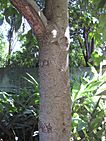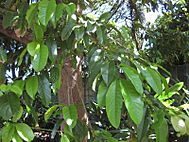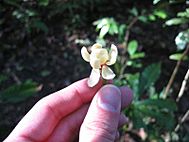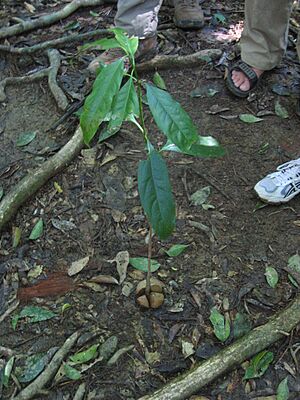Idiospermum facts for kids
Quick facts for kids Idiospermum |
|
|---|---|
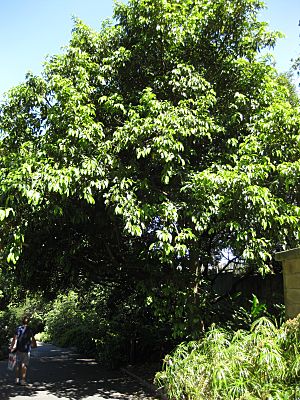 |
|
| Habit in cultivation | |
| Scientific classification | |
| Genus: |
Idiospermum
|
| Species: |
australiense
|
The Idiospermum is a special kind of tree found only in the tropical rainforests of Australia. It's so unique that it's the only species in its entire genus! Its scientific name is Idiospermum australiense, but many people call it the ribbonwood tree.
This tree is like a living fossil because it's one of the oldest types of flowering plants known. Scientists believe its family tree goes back as far as 120 million years! Today, you can only find the ribbonwood in a few places in north-eastern Queensland, specifically in the Daintree and Wet Tropics rainforests. It grows in very wet, low-lying parts of the forest, often in groups of 10 to 100 trees.
Contents
What the Ribbonwood Looks Like
Ribbonwood trees are evergreens, meaning they keep their leaves all year round. In their natural rainforest home, they can grow very tall, reaching about 20 to 40 meters (65 to 130 feet) high. Their trunks can be quite wide, around 90 centimeters (35 inches) across.
The leaves of the ribbonwood are simple and can grow alone, in pairs, or in groups of three or four. Each leaf is usually about 12 to 25 centimeters (5 to 10 inches) long and 5 to 9 centimeters (2 to 3.5 inches) wide.
The flowers are quite large, about 4 to 5 centimeters (1.5 to 2 inches) wide. When they first open, the flower parts are a creamy white color. As the flower gets older, these parts turn red.
The "fruits" of the ribbonwood are very unusual. They don't have the typical protective layers that most fruits do. Instead, these layers break down while still on the tree. What falls to the ground is a very large plant embryo, which is like a baby plant ready to grow. These embryos are huge, about 8 centimeters (3 inches) across! They are also very poisonous and can make animals like cattle very sick.
How Ribbonwood Plants Reproduce
Ribbonwood flowers have both male and female parts, but not all flowers can produce seeds. Some flowers only have fertile male parts.
Small beetles and thrips are the main visitors to the ribbonwood flowers. They are drawn in by the flower's smell and color. These insects crawl inside and lay their eggs near the flower's pollen. As they move around, some of the sticky pollen gets stuck to their bodies. If they then visit another flower that is ready to be pollinated, they will help the plant make seeds. This process is called pollination.
Most modern flowering plants produce seeds with either one or two "seed leaves," called cotyledons. But the ribbonwood is different! Its seedlings can have anywhere from two to five cotyledons. Also, a single ribbonwood seed can sometimes grow more than one shoot, usually one for each cotyledon.
Seeds and How They Spread
The seeds of the ribbonwood tree mostly spread by rolling down steep mountain slopes, helped by gravity. These seeds are so poisonous that most animals can't eat them without getting very sick. However, there is one native animal, the musky rat-kangaroo, that is known to carry and bury some of these seeds. Scientists think that a very large, now-extinct animal called a Diprotodon might have helped spread the seeds in the past.
The ribbonwood has a special poison in its seeds called idiospermuline. This chemical helps protect the seeds from being eaten by animals. Researchers have found that this poison affects how messages travel between nerve cells, which can cause seizures.
Where the Name Comes From
The name Idiospermum comes from two Ancient Greek words: idios, which means "unique" or "peculiar," and spérma, which means "seed." This name perfectly describes the very unusual seeds of this tree!
How Scientists Discovered It
The first European-Australians to notice these trees were timber cutters in the late 1800s, south of Cairns. For a while, people thought the tree had become extinct.
However, a German botanist named Ludwig Diels described the species in 1902. But then, when Diels returned to where he found the tree, the forest had been cleared for a sugar cane farm, and the tree was thought to be extinct again.
Then, in 1971, something amazing happened. A farmer named John Nicholas in Daintree thought someone was harming his cattle. A government veterinarian, Doug Clague, found whole ribbonwood seeds in the cows' stomachs. He realized these seeds were making the cattle very sick, causing spasms and nerve problems. He sent samples to the Queensland Herbarium, and they told him he had made a huge botanical discovery! The ribbonwood tree had been found again.
See also
 In Spanish: Idiospermum australiense para niños
In Spanish: Idiospermum australiense para niños


